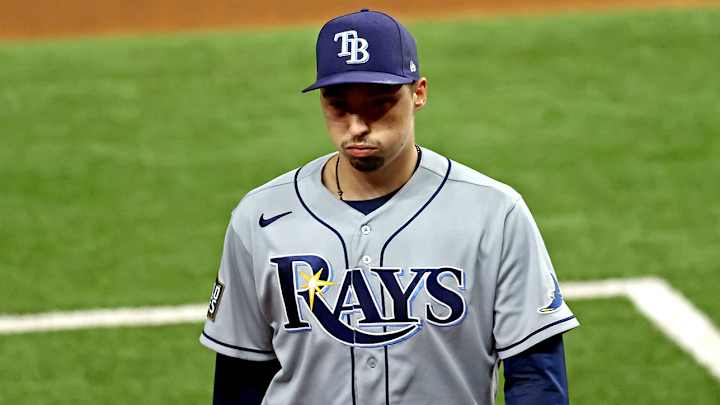The Rays Are Smart. That Doesn't Mean They're Fun

A baseball trade is a statement of organizational philosophy as much as it is a physical transaction. It’s a reflection of a team’s priority (win now? win later? slash payroll?), of its style, of how it values and assesses various types of players. And it’s hard to think of a recent trade that has better demonstrated its team’s respective attitudes than the Padres’ move to acquire Blake Snell from the Rays.
The deal broke through a previously quiet MLB offseason on Sunday night—the former Cy Young Award winner, who has three seasons left until free agency, will head to San Diego in exchange for a quartet of prospects headlined by 21-year-old pitcher Luis Patiño. For the Padres, it’s a deal both smart and flashy, improving their chances of winning right now and in the immediate future, possible because of the flexibility provided by such a deep farm system. It makes a notably fun and dynamic team only more fun and dynamic. For the Rays, meanwhile, it’s a reflection of the exact reasons that you probably already either hate them or love them.
The situation should be familiar by now. The Rays, known for their chronically low payrolls, will grab an opportunity to get prospects for an All-Star caliber player. (See: Corey Dickerson, 2018; Wilson Ramos, 2018; Tommy Pham, 2019.) It’s the sort of move typically associated with cost-slashing instead of pennant-chasing. For the Rays, however, this does not signal the end of a competitive window. Instead, it shows a window that is forever changing shape, made slightly longer but also definitively cheaper, a switch of format rather than of priority.
The Rays are not the only team to pursue trades like this. But they are the only one to have made such a practice of them—so widely understood as part of their identity that it functions as a meme—and there is no finer example than the decision to trade Snell. It’s been scarcely two months since the pitcher had to play the role of tragic hero for the team in the World Series. His contract, thanks to an extension signed in 2019, is well below the market rate he would probably have received from hitting free agency sooner. The Rays are expected to contend; Snell’s presence can only help their rotation. And he was traded anyway.
A subset of initial reactions to the trade, unsurprisingly, clustered on one dismaying point: This is bad for baseball.
The thrust of the criticism is not that the deal was bad for the Rays. It, in fact, is probably quite good for the Rays—prospect evaluation always carries some level of guesswork and wish-casting, but the return package here is impressive and it’s reasonable to call the deal a smart one for Tampa Bay. This is not, say, the Red Sox flipping Mookie Betts, a move whose singular motivation was cutting salary. This is a deal that might very well be for the best. But it’s not hard to see how one can grasp the trade as successful on these terms and still find it generally distasteful.
If fandom is a contract—unspoken, unwritten, but a contract all the same—the team’s end of the bargain is supposed to be acting in good faith. The most basic violation here is a team that does not show appropriate interest or investment in winning. (Just pick your favorite example.) But fans watch for reasons other than the chance to win, and so, of course, there are other ways to violate the contract. There is a deal like this one. It comes partially at a cost for winning—for the present, at least. But the far larger cost is to the sense of any familiar relationship with players, and that, too, is an essential aspect of fandom. To have it ripped out by the roots, again and again, in the name of payroll-cutting and window-adjusting, can feel like a violation of the fandom contract as much as any other.
This might be reminiscent of the conversation that chased the Rays throughout their World Series run in October. The core was the same—is this bad for baseball?—but the context was different. Then, it focused on whether the Rays, with their analytically driven strategy, were fun to watch. That conversation quickly became tedious; for one thing, “fun” is subjective and, anyway, they were in the World Series. What did it matter if their deconstructed pitching staff wasn’t conventionally entertaining at this point? But the center of that debate is somewhat relevant here. It affirmed that there is a reason we watch baseball other than to see who wins and who loses. There is value—experience, relationships, satisfaction—beyond the final score.
The Rays’ approach to roster management can be smart and shrewd and successful under their self-imposed constraints. It often has been all of the above. They may very well win this trade. But, of course, that does not have to mean that you enjoy watching it happen.

Emma Baccellieri is a staff writer who focuses on baseball and women's sports for Sports Illustrated. She previously wrote for Baseball Prospectus and Deadspin, and has appeared on BBC News, PBS NewsHour and MLB Network. Baccellieri has been honored with multiple awards from the Society of American Baseball Research, including the SABR Analytics Conference Research Award in historical analysis (2022), McFarland-SABR Baseball Research Award (2020) and SABR Analytics Conference Research Award in contemporary commentary (2018). A graduate from Duke University, she’s also a member of the Baseball Writers Association of America.
Follow emmabaccellieri